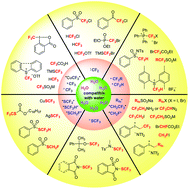Fluoroalkylation reactions in aqueous media: a review
Abstract
This review highlights the progress of aqueous fluoroalkylation over the past few decades. Fluorine-containing functionalities are important design elements in new pharmaceuticals, agrochemicals, and functional materials, due to their unique effects on the physical, chemical, and/or biological properties of a molecule. Because the environmental concerns are receiving increasing attention in organic synthesis, the development of methods for the mild, environment-friendly, and efficient incorporation of fluorinated or fluoroalkylated groups into the target molecules is of broad interest. At the early stage, most of the fluoroalkylation reactions and their variants were thought in principle to be hydrophobic. Recently, the environment-benign fluoroalkylation reactions by taming nucleophilic, radical, or electrophilic fluoroalkylation reagents in water or in the presence of water have been explored, building a new prospect for green chemistry. The use of significant catalytic systems and/or the newly developed reagents is the key to the success of these reactions. Water is used as a (co)solvent and/or a reactant in aqueous fluoroalkylation, including trifluoromethylation, difluoromethylation, monofluoromethylation, trifluoroethylation, perfluoroalkylation, trifluoromethylthiolation, and other conversions, under environment-friendly conditions. Although great accomplishments have been achieved, they are just the tip of the iceberg with a wide scope for improvement. This review will draw great attention and inspire more contributions in the development of new aqueous fluoroalkylation reactions.



 Please wait while we load your content...
Please wait while we load your content...